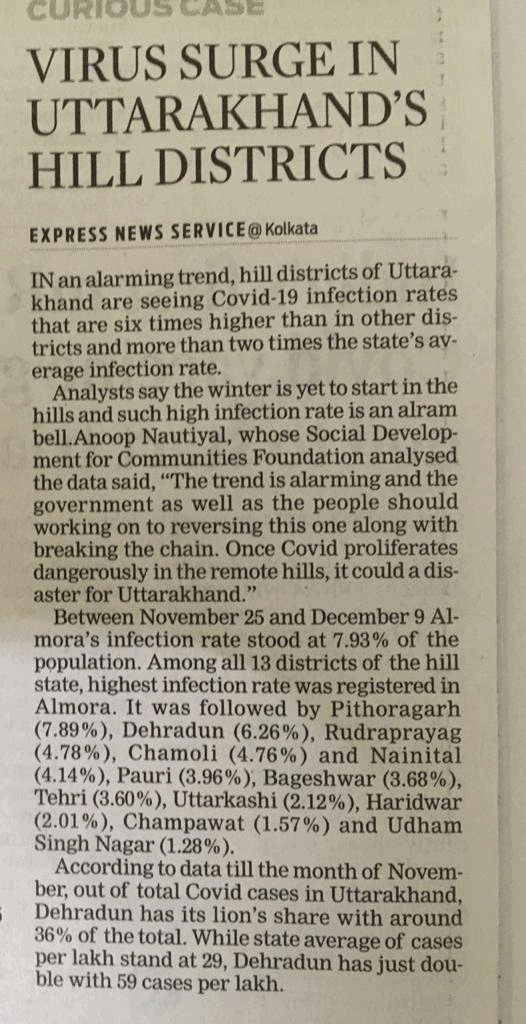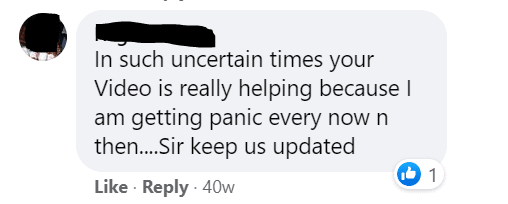“It was a tough time and we were really stressed and worried,” recalled Adarsh, a student pursuing law in a Dehradun college. Adarsh was one of many students who had come to study in one of Dehradun’s many educational institutions who were caught totally unprepared by the sudden lockdown last March. “We really struggled to understand the government rules and make sense of it”.
The challenge, for students like Adarsh and the public at large was two fold. One, the uncertainties arising from the lockdown and two, figuring out the many government advisories in order to plan their travel back to home.
The lack of clear communication by the government posed its own challenges as there was no mechanism to help and advise them on making sense of the information overflow.
“Newspapers reported one thing, social media said something else and WhatsApp forwards made the scenario worse,” said Adarsh. “There was also a lot of inconsistency in what was being put out, creating panic and confusion”.
COVID-19 did not only expose the shortcomings of our public health system but also showed how poor we are with our communication systems.
Information mismatch
The lack of a coherent communication strategy at the central level left states to fend for themselves. As a result, there was increased mismatch between the advisories being issued by the states and centre. For example, the movement of migrant workers snowballed into a full-blown crisis which neither the state governments nor central government was prepared for. States like Delhi and Maharashtra, for instance, struggled to cope up with the crisis due to poor communication strategy.
Read more: All that we know about the COVID shots from the health ministry
Uttarakhand witnessed similar challenges especially in urban centres like Dehradun, Haridwar, Tehri, Srinagar and other towns. People encountered problems with issues like testing protocols, quarantining norms, inter and intra state travelling rules and other advisories being issued by the state government. Students, drivers and migrants struggled at state borders due to gaps in communication regarding what kind of testing and quarantining procedures were being adopted by different state administrations.
“Our business suffered a lot as government guidelines changed frequently and we did not have a way to access and understand them,” says Vinod Rawat, a Dehradun based taxi driver. “For a long time, we kept our movement limited to city travel as there was a lot of confusion overtravel rules”.
Uttarakhand’s first COVID-19 case was reported from Dehradun on March 15th 2020, purshing the city nto a panic mode. Local media kept publishing daily developments pertaining to COVID-19. Gradually, a phase came where it became difficult for citizens to keep track of the latest updates on the crisis. citizens struggled to find credible information on designated COVID-19 care centres, testing labs, protocols and other guidelines. Fake news and dramatic coverage on prime time only made lives more difficult.

Devising new communication tools
That was when Dehradoon based Social Development for Communities (SDC) Foundation decided to run a parallel communication campaign titled “Uttarakhand Fights COVID-19”. The campaign was based on a fundamental premise: simplifying all relevant information and making it easily accessible for the city residents. “We realized early into the pandemic the need to design such a campaign,” says Anoop Nautiyal, Founder, SDC Foundation, residing in Uttarakhand for more than a decade. “We devised a number of outreach tools to target the city wide audience and also other important stakeholders like government departments, civil society organizations, media etc”.
Read more: Apps and more from Pune Smart City to battle COVID, but not all are cheering!
The Foundation planned and executed its campaign on social media. Videos, posters, graphics, newsletters, bulletins, data sheets, text messages and reports were used to reach out to the people. It also started documenting major insights, data and developments related to COVID-19 in Uttarakhand. All of this was shared with the public at regular intervals.
“Globally, close to 90% of internet traffic is being driven via video and audio sources,” says Nautiyal. “We decided to develop and share more video content. This resulted in wider dissemination and people were able to understand the communication that was taking place on COVID-19. The average duration of videos was kept to 3 to 4 minutes. This made the communication short, crisp and to the point”.
SDC took one more basic yet significant step, documenting all the major decisions, SoPs and guidelines issued by the government at one single place. “We created a google drive and shared all the relevant SoPs and guidelines through the same. This solved the issue of accessibility”. The videos put out on social media generated lots of queries and engagement for the Foundation. A team was set up to moderate these comments.
“SDC’s video content was free of any propaganda and based entirely on facts and data,” says Dr B K Joshi, Former VC, Kumaon University and former chairman of Fourth Finance Commission of Uttarakhand. “The campaign simplified data at every level. This made it more inclusive and holistic. The campaign succeeded in creating a dialogue with the citizens, which is missing in government communication”.
SDC also created several Information, education and communication based materials like City Leadership Handbook and posters. The handbook, drafted in Hindi, listed practices for managing COVID-19 at a community level. The handbook was meant for stakeholders like RWA committees, municipal councillors, ward supervisors, municipal commissioner, urban development department, non-government organizations, media and others.
The handbook enabled these stakeholders to create localized actions and prepare a more adequate response to the pandemic by adhering to norms of social distancing, mask wearing, management of delivery of essential items etc.
These video and text-based tools also explained the numbers behind testing, rise/fall in the infection rate, city/district wise summary of cases, death rate etc. “Due to this, the data became more humane and people started understanding it,” explains Nautiyal. “Talking from a layman point of view, without storytelling and simplification, nobody understands data. We made it possible”.

All this data was extensively used and quoted by the local media in its reports. “The reason why this campaign came out as a positive step was because of its crisp and clear analysis”, says Rakesh Khanduri, State Bureau Chief, Amar Ujala. “Health department used to publish the bulletin but there was no analysis or explanation on the issues. Also, it was poorly presented which left no scope for the citizens to engage with it”.
Khanduri explains that the campaign has created a rich inventory of data, trends and insights on COVID-19, which will remain valuable even after the crisis is over and that such inventorization plays a vital role in future decision and strategy making.
So far, the SDC Foundation has created 19 data centric and awareness related videos on COVID-19. From April till December 2020, these videos have received more than 9.5 lakh views across all social media platforms. The Foundation also crafted a separate strategy for WhatsApp platform. The messages were circulated in more than 25 public groups having participants ranging from 10 to over 100.
The learnings and the way ahead?
“The state government follows a very traditional and rigid way of communication like issuing press releases, statements by government speakers etc which makes the entire exercise one way and boring”, explains Dr Joshi. “Government needs to do away with the top down approach to communication and overhaul it. They need to directly communicate with the public, this will build trust”.
As a state, communication has been a challenge for Uttarakhand. COVID-19 exposed the many gaps and poor communication practices of the state government. “SoP were issued always during the night time,” pointed out Khanduri. “We hardly had any time to go through it and report on it the next day. Also, there was no one in the department who could have helped us in understanding the same”.
In Dehradun, for instance, the District Administration and Municipal Corporation have struggled to set up direct and engaging dialogues with citizens. There had been no learning from the severe dengue crisis in 2019. Even then the municipal corporations didn’t hold a single press conference or release a bulletin or analysis concerning the dengue outbreak. It was the same with the COVID-19 crisis. The website of Dehradun Municipal Corporation fails to provide even basic civic services online.
“In Dehradun, I have not seen a single communication initiative by the civic body so far,” said Dr Joshi. “It is still the same old way. It has to engage in meaningful dialogue with its citizens”.
Instead of only issuing press releases, the people would like the District Administration to engage in a participative communication exercise and share information on key district works, policies, programs etc. “Communication should be the top priority for the district administration”, says Khanduri.
There have been a few innovative communication practices, though. The Forest and Police Departments have been engaged in some creative communication over the past few years. Departments have used modern day messaging techniques to connect with their audience. For example, last year the Forest Department used dialogues from famous bollywood movies to raise awareness on forest fires, a major issue in the state. It was appreciated widely. Similarly, the Police Department has made use of creative films, animations and posters to engage citizens on road safety.
However, these initiatives remain a rarity. There is no focus on communication at an institutional level. “Most of these examples are individual driven,” said Nautiyal. “The moment an officer is transferred, these initiatives are abandoned. We need to institutionalize robust communication practices in the state and cities”.
Also read:
